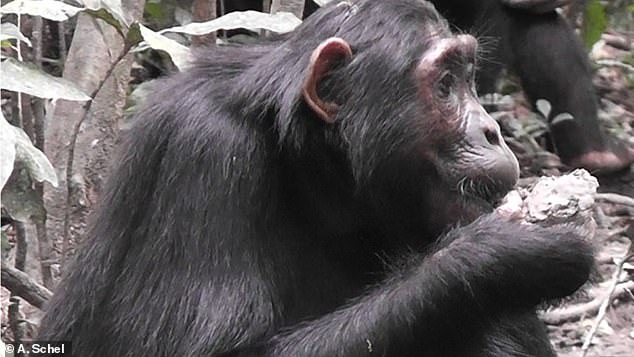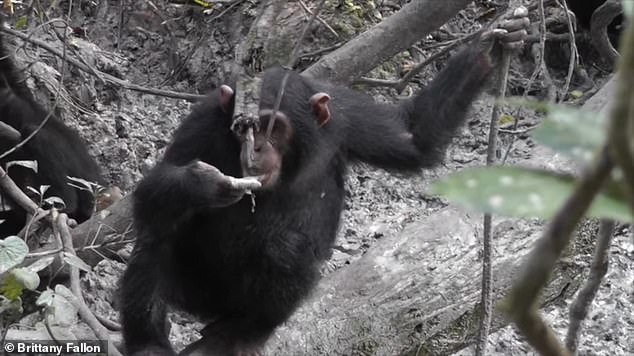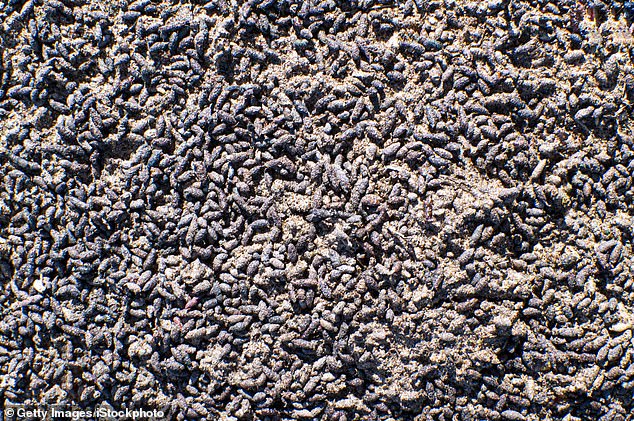Chimpanzees are now eating disease-ridden bat feces as over-cultivation wipes out food sources in Africa… and experts warn it could trigger the next pandemic
Chimpanzees in a protected Ugandan forest are being forced to eat disease-ridden bat feces due to over-cultivation – and experts fear it could trigger the next pandemic.
Scientists observed chimpanzees, monkeys and antelopes consuming the guano over the course of two years – the first time this has been observed in the wild.
Deforestation due to tobacco cultivation has wiped out one of the animals’ normal food sources: the raffia palm.
Experts suspect they are now turning to bat poop because it is rich in calcium, magnesium, iron and other essential nutrients they used to get from the palms of their hands.
But bats are notorious for transmitting diseases. An analysis of the guano by the team of researchers from the US, Britain and Uganda found it contained 27 different viruses, including one coronavirus, previously unknown in humans.
These photos, taken with a motion-sensitive trail camera, captured: A) a guano pile at the opening of a tree where bats roost; B) chimpanzees that eat guano; C) black and white colobus monkeys eating the guano; and D) a red duiker, a species of antelope, that eats the guano.

It is not uncommon for chimpanzees to supplement their diet with clay soil, as seen here. But clay does not contain nearly as many viruses as bat guano.
Researchers are now concerned that all animals may be carriers of bat-borne diseases, which may have led to devastating outbreaks such as Ebola and SARS-CoV-2, which spread from mammals to humans.
In a new study published in the magazine Communication Biologyscientists have shown that chimpanzees in the Budongo Forest Reserve in Uganda regularly eat bat guano.
From 2017 to 2019, the monkeys ate guano at least 92 times on 71 different days, confirming the first report of wild primates eating bat guano.
Black and white colobus monkeys also fed on the guano 65 times, and red duiker antelopes licked it 682 times.
When the team behind the study first saw chimpanzees eating bat feces, they were shocked and concerned.
“Aside from the ick factor, we all had the exact same thought,” lead researcher Tony Goldberg, a veterinary epidemiologist at the University of Wisconsin-Madison, told me. Science.
“They have to be exposed to terrible bat-borne viruses.”
This could be a big problem, scientists say.
This fear is based on the real history of infectious diseases such as Ebola, SARS-CoV-2 and anthrax, all of which are believed to have originated in bats.
These diseases likely adapted to infect chimpanzees or monkeys and then infect humans who came into contact with their carcasses, scientists suspect.
Until now, it was not clear how the bats infected the intermediate animal and transmitted the diseases to humans.
But the new observations of chimpanzees eating bat guano draw a straight line between the two animals.
By documenting this habit, the team has shown the world a “completely underappreciated way” in which new viruses can spread from bats to other animals and possibly humans, said evolutionary biologist Pascal Gagneux, who was not involved in the study.
“These authors document an extremely terrifying ‘ecoquake,'” he said.
Guano is not a first choice delicacy for the chimpanzees.
Instead, they are driven to do so by human activities in and around their homes.
Tobacco farming in Uganda has been a disaster for the chimpanzees’ usual diet, the raffia palm.
This feathered palm used to be the main source of many of the animals’ essential minerals: calcium, iron, potassium, magnesium, manganese, sodium and phosphorus.
The monkeys ate the insides of rotting raffia palm trunks to obtain these nutrients. They also do this with clay soil and termite mounds.
But local tobacco farmers use the leaves of the raffia palm to bundle their crops, and by 2012 the tree was virtually eradicated from the Budongo forest.

Clay is rich in essential micronutrients that chimpanzees need to survive, and scientists have long known that Uganda’s animals eat it.

Bat guano has long been popular as a fertilizer due to its high nutrient content. But chimpanzees now also supplement their diet with it.
Not long after, researchers like Goldberg and his colleagues began seeing the chimpanzees trying bat guano, which they found piled at the entrance to hollowed-out trees where bats roosted.
In the sixty years that scientists had been mapping the monkeys’ behavior, no one had reported this to them.
Goldberg and his team tested samples of the guano and found that it is rich in the same essential nutrients as clay and raffia palms.
“The guano contained concentrations of potassium, magnesium, sodium and phosphorus that were equal to or higher than concentrations in other dietary sources,” the team wrote in the study.
